
|   |

|   |
Sweating Saris and Other Dance Conversations - Ketu H. Katrak e-mail: khkatrak@uci.edu Photos: Radha Satyadev September 14, 2016 Irvine City Hall in Southern California was brought to life by ‘Dance Conversations 2016: Dancing Communities, Dancing Cities,’ co-convened by Ramya Harishankar and Dr. Priya Srinivasan on September 2-3, 2016. The site itself of City Hall made a provocative commentary on the city itself, located in Orange County that has seen a growing diversity of its population over the past several years. Both the outdoor Piazza (plaza), the adjoining Bill Barber Park, and the inner chamber of the City Hall were used as evocative sites for the artistic work. ‘Dance Conversations 2016’ (partly funded by California Arts Council's Local Impact Grant) follows others in the past beginning nearly a decade ago when it brought together Indian dance teachers and choreographers located in Southern California in dialogue and performance—in itself quite an achievement--along with South Asian Modern dance practitioners and educators from the University of California campuses. Another more recent iteration of ‘Dance Conversations: Theatre in Dance’ showcased artists and scholars from India, Canada, and parts of Europe in exploration of the body in synergy with theatrical elements, such as text and voice along with the improvisational, modern and postmodern vocabularies visible on the Indian dancer. Dance Conversations 2015 explored music in dance and community with prestigious composer Dr. Kannikeswaran who worked with western orchestral musicians, contemporary dancers, and Indian community singers and dancers. In 2016, the co-conveners engaged with the city of Irvine itself and its various communities, honoring both the local and reaching out to the global. Questions such as the relationship of individuals to this car-oriented city that they inhabit, their connections to its varying places and outdoor parks were explored. Kudos to the production of this event by Harish Murthy, a key player on the Ektaa Board, and media consultant Visalini Sundaram. A very well-designed program booklet is an exemplary document with information on the two-day events, artist bios, and information on Ektaa Center located in Irvine. Dance Conversations 2016 began on September 2 with a panel entitled ‘Writing in Dance’ that explored such topical issues as the crisis in writing about the arts, and dismally shrinking patronage and funding. The panel included an effective range of voices from the print and online media venues that include commentary on the arts--Mr. V. Ramnarayan, Editor (since 2006) of Chennai-based Sruti magazine, India’s leading performing arts monthly, Paul Hodgins, a theater and dance critic for The Orange County Register newspaper since 1993, including other entertainment trade publications such as Variety, American Theater among others, and Mallika Rao, writer at The New Yorker, and other online publications, previously the Huffington Post’s senior arts and culture reporter. The discussion included facing the reality of not having enough arts commentators who are trained and thoughtful in this kind of writing, and who would, in the spirit of the best critical feedback, enable creative work to grow and even change direction. Media outlets have definitely been the life-blood in providing publicity for arts events. However, there remains a dearth of critical engagement with the arts. It was pointed out that audiences, and readers of print and online reviews need to express this need to editors and other managers of online sites. 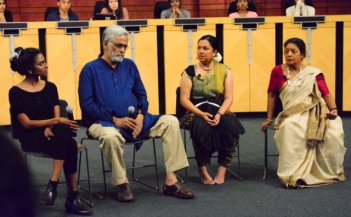
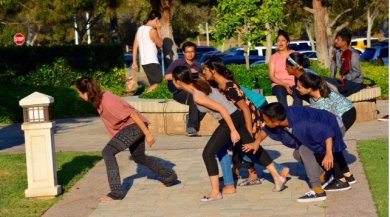
September 3 began with a focus on the city, enlivened by a performance called “Walking in Orange” (Irvine is located in Orange County), at 6pm performed in the Bill Barber Park adjoining Irvine City Hall. This site-specific work, choreographed by Priya Srinivasan and Susan Rose (Professor Emerita of Choreography, UC Riverside) brought together dancers from different dance and music backgrounds from Irvine Valley College’s Dance Program facilitated by Kathryn Milostan Egus, and Ramya Harishankar’s Arpana Dance Company’s Bharatanatyam students. They walked in pairs, growing to threes and fours, exploring the idea of mobility in a car-focused city. They walked together and individually expressing their movement styles as varied as freestyle hip-hop, belly dancing, jazz dance, Kathak and Bharatanatyam. The dancers also spoke about their connection to the city, its diversity, and the challenges faced at times by people of color who may feel exoticized and marginalized. The live soundscape was totally engaging and unique provided by Orange county resident Mayuri Vasan, a trained Carnatic music vocalist who melodiously rendered raga alapanas, accompanied on the violin by Kiran Athreya of Irvine, and Arun Ramabathiram from Los Angeles, on electric guitar. This was perhaps the first time that such a dance/music “happening” took place in Irvine! The multi-layered work was inspired by choreographer Priya Srinivasan’s global experiences as an artist who grew up in Australia, and who has lived in the US, in China, in the Netherlands and has performed in galleries, universities and museums in Holland, Germany among other European cities along with Priya’s use of spoken word with dance as part of her “talking dance” format for presentations. After “Walking in Orange”, the performers led the audience to the Irvine City Hall Plaza where two outdoor performances entitled, “Bharatanatyam Reimagined” by Ramya Harishankar’s students unfolded beautifully outdoors in the twilight hour. As the program notes state: “Living in Irvine, we are contemporary artists performing classical forms but how do we enable audiences to see and understand us without exoticizing?” Three dancers performed Anusha Kedhar’s (Ramya’s senior student) beautifully choreographed ‘Alarippu’ followed by an energetic and striking choreography by Ahila Gulasekaram (another one of Ramya's senior students), performed by eight Bharatanatyam trained dancers in pastel colored flowing tops and loose salwars. Live music by Ravindra Deo on tabla, oboe /vocals by Rohan and vocals by Visalini and her two sisters. Christopher Garcia, a multi-faceted percussionist, added an eclectic array of musical instruments from Mexico, India, and other places creating an imaginative array of sounds along with the movement. 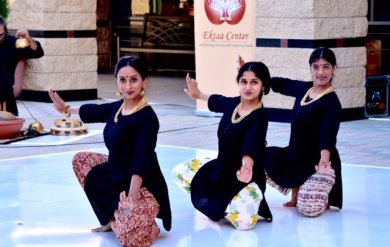
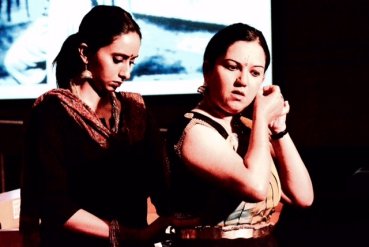
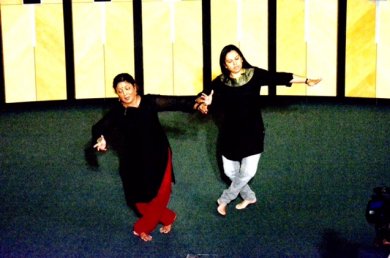
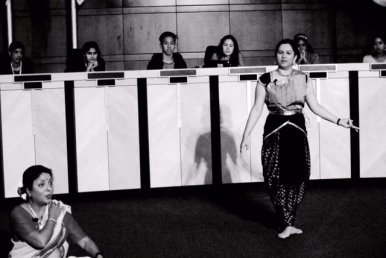
The final highlight of the two-day event was a very successful and thought-provocative ‘Performance as Research’ creative choreography entitled “Sweating Saris” based on Priya Srinivasan’s award-winning book entitled, Sweating Saris: Indian Dance as Transnational Labor (Temple University Press, 2012). This unfolded inside the inner sanctum, as it were, of Irvine City Hall Council Chambers where the councilors were the young dancers who had performed earlier in the evening on the City Hall’s outdoor Plaza, and in the Park, now sitting in plush swivel chairs arranged in the round, looking at the performance by their guru Ramya Harishankar, and her friend and collaborator Priya Srinivasan. “Sweating Saris” was a complex, interactive, multimedia work that deconstructed the finished and polished Bharatanatyam stage performance usually witnessed by an audience that remains unaware of its pre-performance state as “a form of labor.” This idea is explored in Srinivasan’s book where the early 20th century history of Indian dance is contextualized. Srinivasan excavates certain hidden histories, bringing to light the unacknowledged influence of Indian nautch dancers on Modern dancer Ruth St. Denis, followed by Martha Graham. While these Western icons of Modern dance do not acknowledge the insights they derived from the Indian performers, the exact opposite scenario is rife on the Indian scene where artists pay huge obeisance to their gurus. This is part of Indian tradition that will continue, asserting a lineage and legacy of the classical arts; however, at times, such valorization of gurus can be overdone. This historical backdrop to the “performance as research” was conveyed and interrupted in effective post-modern ways, by Priya herself taking on her different autobiographical roles with a wonderful sense of humor and levity involving the audience as participants on her journey. First, she plays being a student of Bharatnatyam in Melbourne, Australia under guru Dr. Chandrabhanu, the rigors of that teacher-student relationship fraught as such relationships often are, with issues of labor and power, then transforming to another stage of her academic life when she came to Ramya’s studio in Irvine to observe her teaching, then taking class with her. Ramya as guru, played out how her teaching transpires in the diaspora to American-born students of Bharatanatyam. Ramya’s knowledge of certain padams and javalis, her melodious singing voice in Carnatic style were all inspiring modalities for translating the meaning and movements of the old padams to her modern students. Priya transforms from wearing black leggings and kurta to putting on layers of clothing right on stage into a modern day performer whose style of costume harkens back to the early dancers, in particular, a projected visual image of T. Balasaraswati in araimandi with loose pants and fitting blouse. Even in a more performative non-verbal than her earlier talking mode, Priya continues to break the flow of her movements with questions often directed to the audience, questioning the teaching process of Indian dance, and the knowledge of its historical and socio-political contexts often left out of the teaching. The point is made subtly that there is use of improvisation both in traditional Indian dance as well as in contemporary dance, and that it is as important to revisit, deconstruct, unpack the wealth in traditional forms as it is to remain open to the wealth of movement and sound styles in a globalized world that we all inhabit in the 21st century. Ketu H. Katrak is Professor, Department of Drama, at the University of California, Irvine. She is the author of ‘Contemporary Indian Dance: New Creative Choreography in India and the Diaspora’ (Palgrave Macmillan, 2011). |